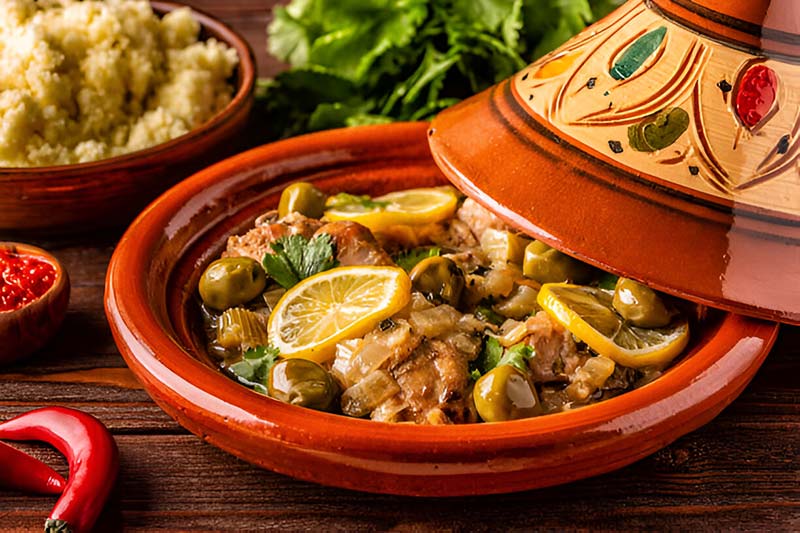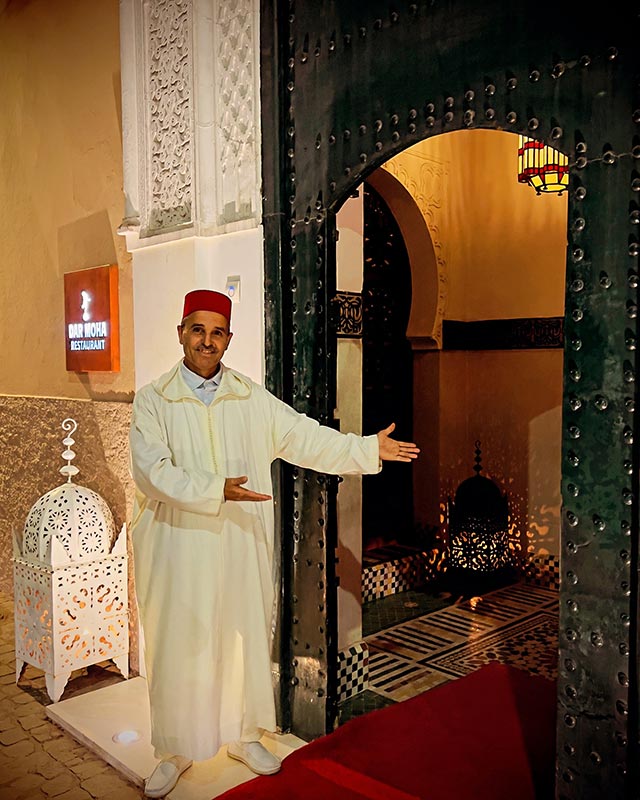Moroccan cuisine is a delightful mix of flavors and aromas. It’s known for its rich, spicy dishes that are full of taste. Moroccan food is more than just eating; it’s a part of the culture and traditions.
People in Morocco love to share meals with family and friends. It’s common to see big gatherings where everyone enjoys food together. This makes Moroccan dining special and fun.
We will look at traditional dishes, learn cooking techniques, and discover famous restaurants. You will find something interesting here whether you are a beginner or a food lover.
We will start by diving into the traditional dishes that make Moroccan cuisine so famous. These dishes are loved by many and have been passed down through generations. Let’s explore the heart of Moroccan meals and discover what makes them so unique.
Traditional Moroccan Dishes
Moroccan food is known for its flavorful dishes. These meals are often cooked with spices and herbs, making them delicious and aromatic. Let’s explore some of the most famous Moroccan dishes that people love.
Signature Dishes
- Tagine is a slow-cooked stew made with meat, vegetables, and spices. It is named after the clay pot in which it is cooked. The unique shape of the pot helps the food stay tender and juicy. Common ingredients include chicken, lamb, apricots, and almonds. Each family has its own way of making tagine, but it is always rich in flavor.
- Couscous is tiny pasta made from wheat. It is often served with meat and vegetables. The dish is steamed until it is light and fluffy. People usually enjoy couscous on Fridays, the holy day in Morocco. It’s a favorite dish for family gatherings and celebrations.
- Pastilla is a special pie that combines sweet and savory flavors. It is made with layers of thin pastry, filled with spiced meat, usually pigeon or chicken, and topped with powdered sugar and cinnamon. The mix of tastes makes it a unique and delightful dish, often served at weddings and special events.

Different parts of Morocco have their own special dishes. In the coastal areas, seafood is very popular. In the mountains, people enjoy hearty stews and soups. Each region adds its own twist to traditional recipes, making Moroccan cuisine diverse and exciting.
Key Ingredients and Spices
Saffron is a precious spice used in many Moroccan dishes. It gives food a golden color and a special taste. Saffron is often added to rice, tagine, and desserts, making them look and taste wonderful.
Cumin is a spice that adds warmth and depth to Moroccan food. It is used in many dishes, from meats to vegetables. The earthy flavor of cumin makes the food rich and satisfying. It is a key ingredient in Moroccan cooking.
Cooking Techniques
Moroccan cooking is known for its special methods. These techniques help make the food tasty and full of flavor. Let’s learn about how Moroccan dishes are prepared.
One popular method is slow-cooking in a tagine. The tagine is a clay pot with a cone-shaped lid. This shape helps keep the steam inside, making the food moist and tender. Meat and vegetables cooked in a tagine are rich in flavor and very soft.
Making couscous by hand is another important technique. First, wheat is ground into small grains. Then, the grains are steamed over boiling water. This makes the couscous light and fluffy. It takes skill and patience to prepare couscous the traditional way.
Even though traditional methods are still used, some people have added modern touches to Moroccan cooking. For example, they might use electric tagine pots or steamers to save time. These new tools help make cooking easier while still keeping the food’s original taste.
One secret to great Moroccan cooking is balancing flavors. Chefs use a mix of spices, herbs, and other ingredients to create a perfect taste. For example, they might add a bit of sweetness to a spicy dish to make it just right.
To make the best tagine, chefs often marinate the meat before cooking. This helps the flavors soak in and makes the dish even more delicious. Using fresh herbs and high-quality spices also makes a big difference.
With these cooking techniques in mind, we can see how Moroccan food becomes so delicious and unique.
Famous Restaurants in Morocco
Morocco has many well-known restaurants where you can enjoy its tasty dishes. These places offer a great dining experience and let you try authentic Moroccan food.
Let’s take a look at some of these famous spots.

Dar Moha is a famous restaurant in Marrakech. It is located in a beautiful riad, which is a traditional Moroccan house. The restaurant is known for its creative take on classic dishes. Visitors can enjoy meals like tagine and couscous in a lovely garden setting.
Al Fassia is another popular restaurant, also in Marrakech. It is special because it is run by women. The restaurant offers a mix of traditional and modern Moroccan dishes. Their pastilla is especially famous. It’s a great place to experience the warmth and hospitality of Moroccan culture.
Local markets in Morocco are full of delicious food. You can find stalls selling fresh tagine, grilled meats, and sweet pastries. Eating at these markets gives you a true taste of Moroccan life. The food is often made right in front of you, which makes it even more exciting.
Family-owned restaurants are also a big part of Moroccan dining. These places are often small but offer very tasty meals. The recipes have been passed down through generations. Eating at these restaurants feels like being part of the family.
After exploring these amazing restaurants, you might want to try cooking some Moroccan dishes at home.
Recipes and Cooking Tips
Cooking Moroccan food at home can be fun and rewarding. Here are some recipes and tips to help you make delicious Moroccan dishes.
To make a tasty tagine, you will need chicken, onions, garlic, olives, lemons, and spices like ginger, cumin, and turmeric. First, mix the spices with the chicken and let it marinate. Then, cook the onions and garlic in a tagine pot. Add the chicken, olives, and lemons and let it cook slowly until tender.
Couscous is simple to make. You will need couscous grains, water, and a bit of olive oil. Boil water and pour it over the couscous. Cover and let it steam. After a few minutes, fluff the couscous with a fork and add olive oil. Serve it with vegetables or meat.
Spices are very important in Moroccan cooking. Use fresh spices like saffron, cumin, and cinnamon. These spices add a lot of flavor to the dishes. Always store your spices in a cool, dry place to keep them fresh.
To get the best results, always use good-quality ingredients. Fresh vegetables, meats, and herbs make a big difference. Take your time with cooking. Slow-cooked dishes like tagine need patience but are worth the wait.
With these recipes and tips, you can bring the taste of Morocco into your home.
Practical Dining Recommendations
Visiting Morocco and tasting its food is an exciting adventure. Here are some tips to help you enjoy Moroccan dining to the fullest.
When in Morocco, be sure to try tagine, couscous, and pastilla. These dishes are staples of Moroccan cuisine and give you a real taste of the country. Don’t forget to try Moroccan mint tea; it’s refreshing and a big part of the culture.
Food festivals are a great way to experience Moroccan cuisine. The Marrakech Food Festival is held in October and offers a variety of dishes to try. Another good time to visit is during Ramadan, when special meals are prepared for Iftar, the evening meal.
Moroccan menus can be long and varied. Look for dishes with ingredients you enjoy. If you are unsure, ask the waiter for recommendations. Many restaurants offer a mixed plate, which lets you try a bit of everything.
In Morocco, meals are often shared. It’s polite to use your right hand when eating, especially if eating with your hands. Bread is a common part of the meal and is used to scoop up food. Be sure to wash your hands before and after eating.
Conclusion
Moroccan cuisine is a delightful journey of flavors and traditions. It’s more than just food; it’s a way of life.
From the spicy tagine to the sweet pastilla, Moroccan dishes are unique and delicious. The cooking techniques, like slow-cooking in a tagine and hand-preparing couscous, make the food special. Famous restaurants and local markets offer a true taste of Morocco. They let you experience the warmth and hospitality of Moroccan culture.
Whether you cook Moroccan dishes at home or try them in Morocco, you will enjoy the rich flavors and aromas. Use the recipes and tips provided to make your Moroccan feast. If you get the chance to visit Morocco, make sure to try the local food and follow our dining recommendations.
Enjoy the journey into Moroccan gastronomy and savor every bite!
